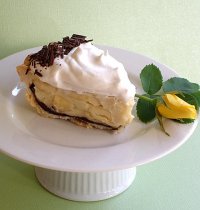 Tempering is to slowly bring up the temperature of an ingredient sensitive to heat, such as eggs or milk, to prevent it from curdling, breaking, or cooking too fast. For example, when tempering eggs with hot milk, it is done by adding a small portion or measured portions of the hot component (the milk) to the cooler ingredient (the eggs) and stirring it in before adding the now-warmed ingredient to the rest of the hot component (hot milk in the large pot) or returning all of it. The technique slowly raises the temperature of the eggs, without heating them through conventional methods. If the liquid is hot milk, tempering helps prevents it from curdling from the additional of cold eggs.
Tempering is to slowly bring up the temperature of an ingredient sensitive to heat, such as eggs or milk, to prevent it from curdling, breaking, or cooking too fast. For example, when tempering eggs with hot milk, it is done by adding a small portion or measured portions of the hot component (the milk) to the cooler ingredient (the eggs) and stirring it in before adding the now-warmed ingredient to the rest of the hot component (hot milk in the large pot) or returning all of it. The technique slowly raises the temperature of the eggs, without heating them through conventional methods. If the liquid is hot milk, tempering helps prevents it from curdling from the additional of cold eggs.
Tempering is also used when adding melted chocolate to a recipe, where you want to bring down the temperature of the chocolate so it won't seize when added to the much cooler batter or recipe. This is not to be confused with Chocolate Tempering Techniques used when making confections.
TEMPER WHEN ADDING UNCOOKED EGGS INTO HOT LIQUID:
This technique is used with the:
 Pastry Cream Recipe Tutorial
Pastry Cream Recipe Tutorial
 Chocolate Thick Pastry Cream Recipe Tutorial
Chocolate Thick Pastry Cream Recipe Tutorial
HOW TO TIPS:
1. Heat the milk, usually until just boiling. I like to let my ingredients cool slightly. Make sure they are still fluid and not too thick. If not, reheat.
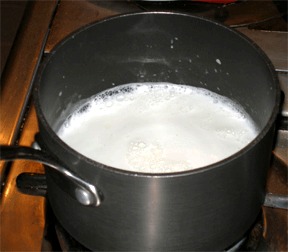
2. Prepare the eggs, in a separate bowl, by lightly beating to combine; the hot liquids will eventually be added to them.
3. First dribble a small amount of hot milk in a steady stream into the eggs while quickly whisking the two together. This raises the temperature of the egg gradually and cools the milk slightly.
4. Drizzle about 1/3 of the hot milk mixture to the egg mixture in the mixing bowl, whisking constantly.
Feel, with your hand, that the bowl's side or bottom has become warm or as close as possible to the liquid's temperature. Doing this is a good indicator of telling if the egg has been warmed up.
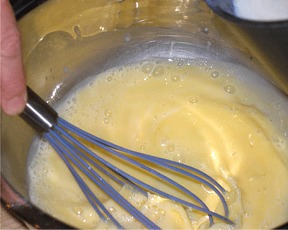
5. Continue to add the rest of the hot liquids in a steady stream to the eggs while whisking. The eggs won't scramble or the milk won't curdle at this point, because they have been warmed gently. But, always keep the mixture moving – don't stop whisking.
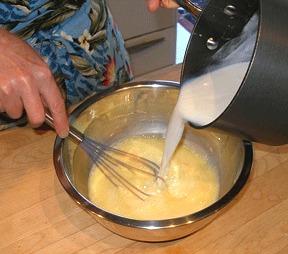
6. Return the mixture to the saucepan. Proceed with the recipe.
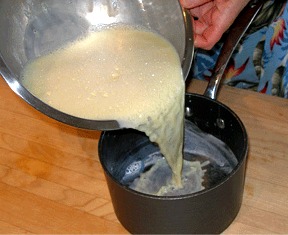
NOTE: If you see any small white clumps in the mixture, then the egg has gone into shock and has curdled, either because the egg was too cold, or the mixing was done too slow. The egg has cooked and has separated from the hot mixture and therefore you have to start all over again with new ingredients. Sometimes the small white clumps can come from the chalazae from the egg whites and all you have to do is simply strain the custard.
TEMPER WHEN ADDING MELTED CHOCOLATE TO A BATTER:
Question: I melted white chocolate in the microwave as I was making a white chocolate raspberry cheesecake. When I went to put it in the batter the chocolate had hardened. I microwaved it some more and put it in the batter, but there were some hard white chocolate pieces in the batter that I had to remove. What did I do wrong?
SARAH SAYS: The chocolate seized, creating small bits of hardened chocolate in the batter. These bits will never melt and incorporate into the batter when the cake bakes; they will remain as hardened pieces of chocolate in the final cake and there is nothing you can do to fix it. It was because the melted chocolate was too warm or hot, and the batter cool. (You can try to fix seized chocolate during melting before it is added to the batter, but it doesn't always work.)
The solution is to temper the chocolate, or bring down the temperature of the chocolate so it is the same temperature as the batter. This is not to be confused with tempering chocolate, a technique by which pure chocolate is stabilized through a carefully controlled melting and cooling process, allowing the cocoa butter molecules to solidify in an orderly fashion and for the chocolate to harden properly.
This technique is used with the:
 Flourless Chocolate Almond Cake or Torta Caprese Recipe
Flourless Chocolate Almond Cake or Torta Caprese Recipe
 Ultimate Chocolate Butter Cake Recipe (UCBC)
Ultimate Chocolate Butter Cake Recipe (UCBC)
How to:
1. Melt and cool the chocolate to until tepid or about 100 to 105 degrees F (slightly warmer than body temperature, which is 98.6 degrees F).
2. Temper the chocolate by adding ONE TABLESPOON of the butter/sugar/egg mixture at a time to the COOLED chocolate and mix thoroughly.
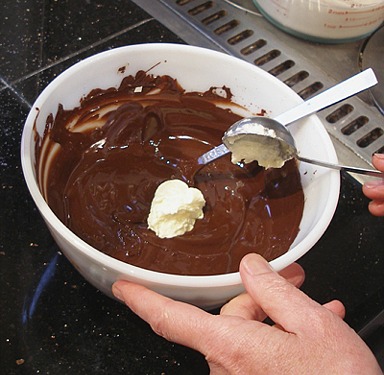
2. STIR IN TWO MORE TABLESPOONS of the butter/sugar/egg mixture to the chocolate mixture, ONE TABLESPOON at a time.
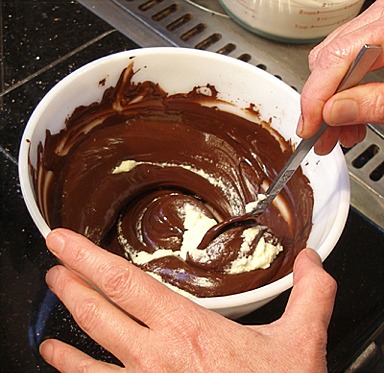
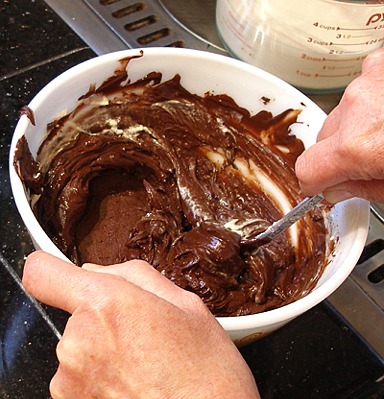
3. Add about 1/4 cup more of butter/sugar/egg mixture to the chocolate mixture before returning it all back into the main mixing bowl.
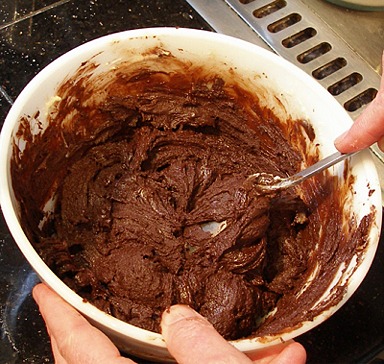
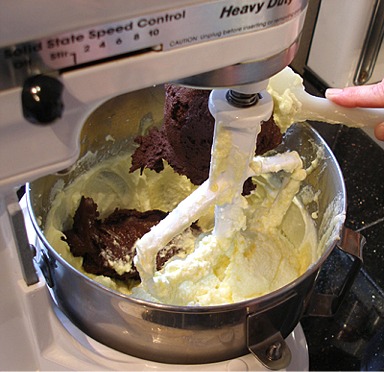
4. Mix all the ingredients on low speed until combined and creamy. Proceed with the recipe.


